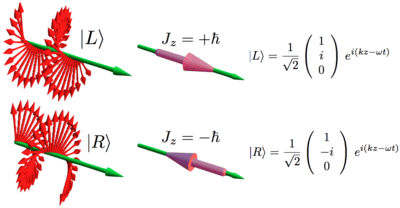Spin angular momentum of light
The spin angular momentum of light (SAM) is the component of angular momentum of light that is associated with the quantum spin and the rotation between the polarization degrees of freedom of the photon.
Introduction
Spin is the fundamental property that distinguishes the two types of elementary particles: fermions with half-integer spins and bosons with integer spins. Photons, which are the quanta of light, have been long recognized as spin-1 gauge bosons. The polarization of the light is commonly accepted as its “intrinsic” spin degree of freedom. However, in free space, only two transverse polarizations are allowed. Thus, the photon spin is always only connected to the two circular polarizations. To construct the full quantum spin operator of light, longitudinal polarized photon modes have to be introduced.

An electromagnetic wave is said to have circular polarization when its electric and magnetic fields rotate continuously around the beam axis during propagation. The circular polarization is left () or right () depending on the field rotation direction and, according to the convention used: either from the point of view of the source, or the receiver. Both conventions are used in science depending on the context.
When a light beam is circularly polarized, each of its photons carries a spin angular momentum (SAM) of , where is the reduced Planck constant and the sign is positive for left and negative for right circular polarizations (this is adopting the convention from the point of view of the receiver most commonly used in optics). This SAM is directed along the beam axis (parallel if positive, antiparallel if negative). The above figure shows the instantaneous structure of the electric field of left () and right () circularly polarized light in space. The green arrows indicate the propagation direction.
The mathematical expressions reported under the figures give the three electric-field components of a circularly polarized plane wave propagating in the direction, in complex notation.
Mathematical expression
General expression for the spin angular momentum is[1]
where is the speed of light in free space and is the conjugate canonical momentum of the vector potential . The general expression for the orbital angular momentum of light is
where denotes four indices of the spacetime and Einstein's summation convention has been applied. To quantize light, the basic
equal-time commutation relations have to be postulated [2],
where is the reduced Plank constant and is the metric tensor of the Minkowski space.
Then, one can verify that both and satisfy the canonical angular momentum commutation relations
and they commute with each other .
After the plane-wave expansion, the photon spin can be re-expressed in a simple and intuitive form in the wave-vector space
where the column-vector is the field operator of the photon in wave-vector space and the matrix
is the spin-1 operator of the photon with the SO(3) rotation generators
, , ,
and the two unit vectors denote the two transverse polarizations of light in free space and unit vector denotes the longitudinal polarization.
Due to the longitudinal polarized photon and scalar photon have been involved, both and are not gauge invariant. To to incorporate the gauge invariance into the photon angular momenta, a re-decomposition of the total QED angular momentum and the Lorenz gauge condition have to be enforced. Finally, the direct observable part of spin and orbital angular momenta of light are given by
and
which recover the angular momenta of classical transverse light[3]. Here, () is the transverse part of the electric field (vector potential), is the vacuum permittivity, and we are using SI units.
We can define the annihilation operators for circularly polarized transverse photons:
with polarization unit vectors
Then, the transverse-field photon spin can be re-expressed as
For a single plane-wave photon, the spin can only have two values , which are eigenvalues of the spin operator . The corresponding eigenfunctions describing photons with well defined values of SAM are described as circularly polarized waves:
References
- Yang, L.-P.; Khosravi, F.; Jacob, Z. (2020). "Quantum spin operator of the photon". arxiv:2004.03771.
- Greiner, W.; Reinhardt, J. "Chap. 7". Field Quantization. ISBN 9783642614859.
- Cohen-Tannoudji, C.; Dupont-Roc, J.; Grynberg, G. (1997). "Chap. 1". Photons and Atoms-Introduction to Quantum Electrodynamics. Wiley-VCH. ISBN 9780471184331.
Further reading
- Born, M. & Wolf, E. (1999). Principles of Optics: Electromagnetic Theory of Propagation, Interference and Diffraction of Light (7th ed.). Cambridge: Cambridge University Press. ISBN 978-0-521-64222-4.
- Allen, L.; Barnnet, Stephen M. & Padgett, Miles J. (2003). Optical Angular Momentum. Bristol: Institute of Physics. ISBN 978-0-7503-0901-1.
- Torres, Juan P. & Torner, Lluis (2011). Twisted Photons: Applications of Light with Orbital Angular Momentum. Bristol: Wiley-VCH. ISBN 978-3-527-40907-5.